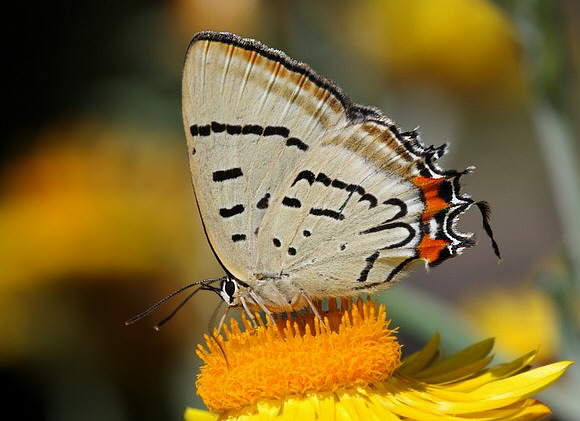
Introduction
The genus Jalmenus comprises of 11 species, all of which are endemic to Australia. The uppersides of most species are metallic silvery-blue, with broad suffused blackish margins, and a pair of small orange or red patches near the tail of the hindwing. In one species eichorni the blue colouration is replaced by metallic green. The undersides vary, some like evagoras having black markings while in others such as lithochroa and icilius the markings are very pale and obscure.
Jalmenus evagoras is found in southern Queensland, Canberra, New South Wales and Victoria.
Habitats
This species inhabits open Acacia scrub and semi-desert habitats.
Lifecycle
The eggs are white or pale yellow and are laid in neat rows on stems of Acacia bushes. Immediately after hatching the caterpillars wander until they find an ant trail. They follow this until they locate a cluster of older caterpillars, which always have Iridomyrmex ants in attendance. Ants are beneficial to the larvae because they drive away predatory insects and parasitoid wasps that might otherwise attack them. Iridomyrmex ants have been observed actively defending Jalmenus caterpillars from attack by predators including spiders, mantises, Myrmecia jumper ants and Polistes wasps.
The larvae have a series of spiky dorsal tubercles, and are dark green with an orange dorsal stripe and marbled with lighter tones. They live within a communal web on a small Acacia bush, emerging to feed periodically.
The pupae are black with orange bands between the segments, and are formed in clusters attached to twigs. The pupae are also attended by Iridomyrmex ants. Experiments have shown that in cases where ants have been denied access to the pupae the latter have suffered up to 95% parasitism by the Chalcid wasp Brachymeria reginia. Conversely, pupae attended by the ants experienced zero parasitism.
Larvae and pupae have been shown able to communicate with ants using visual, audio and chemical signals which are used to appease the ants, which would otherwise attack and kill them.
Adult behaviour
Males aggregate in clusters of up to 20 individuals around the pupae of females on Acacia bushes. Both sexes nectar at Asteraceae and various flowering bushes and shrubs.

